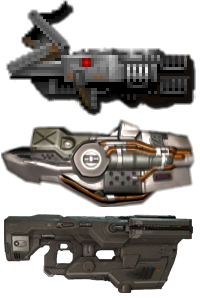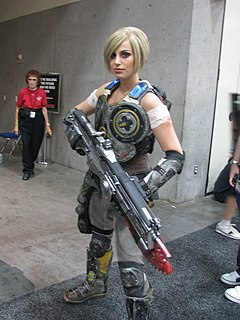 W
WIn video games, a life is a play-turn that a player-character has, defined as the period between start and end of play. It is sometimes called a chance or a try, particularly in all-ages games, to avoid the morbid insinuation of losing one's "life". Generally, if the player loses all their health points, they lose a life. Losing all lives usually grants the player-character "game over", forcing them to either restart or stop playing.
 W
WThe BFG is a fictional weapon found in many video games, mostly in first-person shooter series such as Doom and Quake.
 W
WThe spiny shell, commonly referred to as the blue shell, is a power-up item in the Mario Kart video game series. Originating in 1996's Mario Kart 64 and featured in every main entry of the series since then, the blue shell, when used, aims directly at the racer in first place, stopping them on impact. The blue shell acts as a "catch-up" mechanic, with racers ranked towards the bottom having a better chance of it spawning when driving into item boxes, giving them a better chance at diminishing the lead of the racer in top position. In addition to the Mario Kart series, the blue shell appeared in the Super Smash Bros. series from 2001's Melee onwards, and in Mario Hoops 3-on-3.
 W
WAn eggplant run is a challenge playthrough of the 2012 roguelike-like platform video game Spelunky HD. Such a playthrough centers on carrying an eggplant item to the final boss of the game, King Yama, and tossing it into his face. This eggplant item was originally added to Spelunky as part of an easter egg pitched by the game's composer Eirik Suhrke, and Spelunky's lead designer Derek Yu decided to give it the additional function of turning King Yama into an inert eggplant monster.
 W
WThe Gnasher Shotgun, also known as simply the Gnasher, is a fictional firearm weapon featured in the Gears of War video game franchise. First appearing in the original Gears of War, the Gnasher is the standard-issue shotgun for Coalition of Ordered Governments ("COG") soldiers, although it is also carried by the enemy Locust Horde, particularly the Grenadier class of Locust Drone.
 W
WA gravity gun is a type of device in video games, particularly first-person shooters using physics engines, whereby players can directly manipulate objects in the world, often allowing them to be used as projectiles against hostile characters. The concept was popularized by the gravity gun found in Valve's Half-Life 2, as well as the Temporal Uplink found in Free Radical Design's TimeSplitters: Future Perfect; although a similar concept was used by id Software during the production of the earlier game Doom 3, eventually leading to the introduction of a physics-based weapon in the expansion pack Resurrection of Evil. Later games, such as Portal, BioShock, Crysis, and Dead Space, have been influenced by the success of these physics-based weapons, adopting their own styles of comparable abilities or weapons.
 W
WThe Lancer Assault Rifle, also known as simply the Lancer, is a fictional class of firearm weapons featured in the Gears of War media franchise. Variants of the Lancer appear in the video game series as well as in related media, beginning with Gears of War. The most well known model is the Mark (MK) 2 Lancer Assault Rifle, a mid-range assault rifle with a fully operational chainsaw for a bayonet, and is usually available as one of the starting weapons used by the protagonists of the series.
 W
WThe M6D Pistol, also known as the Halo CE pistol, M6D Magnum Sidearm or M6D Personal Defense Weapon System, is a fictional pistol featured in the Halo franchise of video games. It is one of the starting weapons used by the protagonist, Master Chief, and was designed and manufactured by Misriah Armory, a manufacturer for the United Nations Space Command. Called one of the most infamous video game weapons of all time, it has gained notoriety amongst critics and players for its unusually high power and accuracy, especially for the time it is received in the game. The pistol, or variants of it, appeared in several games in the series, starting in Halo: Combat Evolved, as well as in related media.
 W
WMetal Gear is the name for a series of mecha in the Metal Gear series. In the series, a Metal Gear is defined as a bipedal nuclear weapons-equipped tank. The Metal Gears are typically autonomous nuclear launch platforms which the player must destroy to save the world and complete the game. Often, confronting the latest Metal Gear model is one of the final challenges of each game.
 W
WThe Pip-Boy is a fictional wearable computer in the post-apocalyptic Fallout video game franchise. Manufactured in-universe by RobCo Industries prior to the devastating nuclear Great War, it is capable of numerous functions depending on the model. In the Fallout games, it functions as a diegetic way for the player to access the menu and manage their inventory.
 W
WPower Armor, also referred to as powered combat infantry armor, is a type of powered exoskeleton that appears in the post-apocalyptic Fallout video game franchise. In the fictional lore of the series, it was developed before the Great War, a devastating nuclear conflict, by United States defense contractors. It not only allows for protection from enemy fire, but enables the wearer to carry extremely heavy weapons and other objects with ease. Power Armor has been called an iconic aspect of Fallout, and has featured as an item in many games in the series. In Fallout 4, Power Armor was notably more heavily integrated into gameplay, with suits becoming customizable, interactable objects in the game world that the player climbs into rather than typical clothing, and requiring power cells to use.
 W
WThe Smart Pistol is a fictional handgun used in the Titanfall series of first-person shooter video games. Created for pilots of the game's mechs, known as Titans, it is used to fight adversaries when the pilot is outside of the mech. The Smart Pistol MK5 appears in the first Titanfall, while the Smart Pistol MK6 appears in Titanfall 2. Known as a "controversial", notorious and divisive weapon due to its ability to automatically target and fire at multiple enemies at once, its power was lowered in the sequel, where it was made a temporary weapon. The Smart Pistol was both criticized for how strong its targeting ability was, and praised for its uniqueness and how it lowered the barrier to entry for players who were new to the genre or normally performed poorly in shooters. It was also noted as being similar to real-world smart guns.
 W
WThe Triforce is a fictional artifact from Nintendo's The Legend of Zelda series of video games. Referred to as "The Golden Power" in ancient Hylian literature, it represents the essence of the Golden Goddesses who created the realm of Hyrule that was left behind when they departed the realm for the heavens. It is said to grant godlike power to the one who holds all three pieces and is a main focus of the plot of many games in the series, including The Legend of Zelda, The Adventure of Link, A Link to the Past, Ocarina of Time, Oracle of Ages, Oracle of Seasons, The Wind Waker, Skyward Sword, and A Link Between Worlds. The Triforce consists of three equilateral triangles, which are joined to form a large equilateral triangle. Occasional variations are found in the shape and subdivisions.